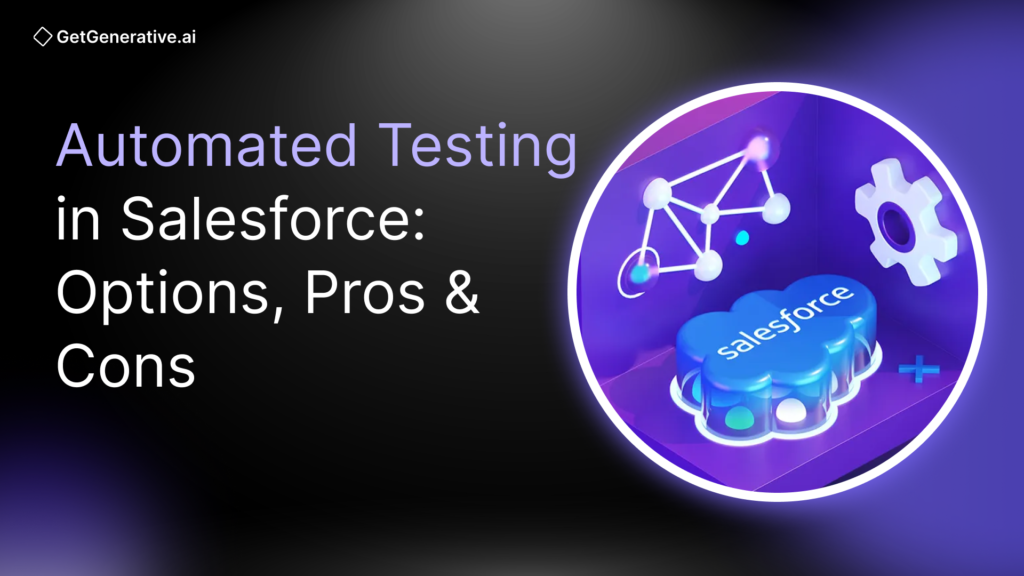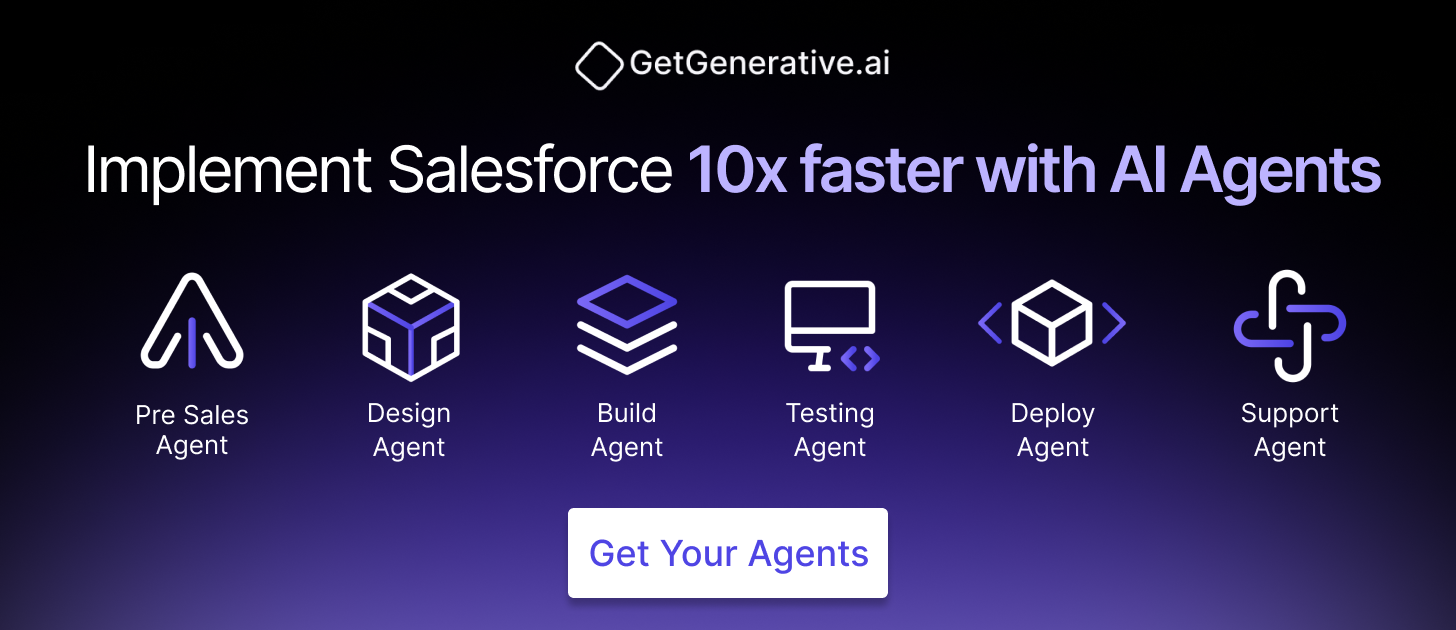Automated Testing in Salesforce: Options, Pros & Cons
According to industry surveys, over 60% of companies see a positive ROI from automated testing. Automated tools detect up to 90% more defects than manual processes. For Salesforce professionals, the question is not whether to automate, but how: Which approach delivers the best balance of coverage, cost, and maintainability?
This comprehensive guide compares native Salesforce test capabilities and top third-party automation platforms like Provar, Copado, Tricentis, AutoRABIT, and Selenium. We evaluate each tool’s strengths, limitations, real-world ROI, and emerging trends like AI-based testing and low-code/no-code test automation.
Let’s get started!
Native Salesforce Testing Capabilities
Salesforce offers powerful, built-in testing mechanisms, particularly for backend logic. These tools are free, integrated, and mandatory for deployment but come with limitations.
Apex Unit Tests and Code Coverage
Apex test classes form the foundation of Salesforce’s native testing. Developers use them to validate server-side logic (triggers, classes, controllers), simulating real scenarios in a sandbox.
- Requirement: Salesforce mandates 75% code coverage for production deployment.
- Advantages:
- No licensing cost
- Tight integration with Salesforce CLI and DevOps Center
- Good for logic validation, batch jobs, and DML operations
- Limitations:
- Cannot test UI (Lightning components)
- Maintenance-heavy for growing orgs
- Performance bottlenecks in large test suites
Lightning Component and UI Tests
Salesforce offers several methods for testing Lightning components:
- Lightning Web Components (LWC) use Jest for JavaScript unit testing.
- Fast, local execution in Node.js
- Ideal for isolated UI behavior (rendering, state, events)
- Aura Components: Formerly supported by Lightning Testing Service (now deprecated)
- UTAM (UI Test Automation Model):
- JSON-based page object model
- UTAM works with tools like Selenium/WebDriverIO
- Improves maintainability across Salesforce releases
While these tools address client-side logic, they do not support end-to-end UI testing across workflows or user journeys.
Declarative and Integration Testing
Declarative tools (e.g., Flows, Process Builder) lack native unit testing.
- Apex tests can indirectly verify flow outcomes
- UI-based flow testing is often required for full regression
- For integrations, developers rely on mocked Apex callouts or external test frameworks (e.g., Postman, REST-assured)
Strengths and Limitations of Native Tools
Strengths | Limitations |
Free, built-in, and required | No end-to-end UI coverage |
Tight integration with deployment tools | Cannot simulate multi-org or external flows |
Code coverage metrics aid quality | No no-code recorders or test data tools |
Supports CI/CD pipelines (CLI, DevOps Center) | Manual script creation and maintenance |
Conclusion: Native testing is essential but not sufficient. Apex and LWC tests form the QA foundation, but full regression, UI flow validation, and cross-system testing require more specialized tools.
“Test automation was never about replacing humans. Its goal was never to test everything, and it was certainly never intended to be the panacea for software quality problems.”
— Josh Meier, Software Engineer at Salesforce
Top Third-Party Salesforce Testing Tools
Numerous automation platforms extend Salesforce QA capabilities beyond native limitations. These include:
Provar
Positioning: Built exclusively for Salesforce, Provar offers metadata-driven, low-code test automation.
- Features:
- Metadata-aware test builder
- NitroX engine for resilient locators
- Cross-cloud support (Sales, Service, Industries)
- Rich desktop and cloud execution options
- Use Case: Best for orgs needing deep Salesforce regression coverage
Pros:
- Strong metadata alignment → tests survive UI updates
- Reduced script maintenance
- Detailed logs, screenshots, and dashboards
Cons:
- Windows-based desktop client
- High memory usage reported
- Commercial licensing with enterprise pricing
Real-World ROI:
PatientPoint, a healthcare firm, reduced regression time by 90% (3 days → 3 hours) using Provar.
A global tech company reported increased test coverage and faster release cycles after adopting Provar.
Copado Robotic Testing
Positioning: Part of Copado’s DevOps platform, it enables no-code, AI-powered test automation for Salesforce and beyond.
- Features:
- Live recorder and flow editor
- Self-healing locators via AI
- Parallel test execution in the cloud
- CI/CD integration and test analytics
Pros:
- No local setup (cloud-based execution)
- Codeless flowcharts for test building
- Native integration with Copado ALM and pipelines
Cons:
- Requires Copado license
- Windows agent setup required for some features
- Still involves a learning curve for flow-based scripting
Real-World ROI:
OneAmerica Finance cut test script creation time from 4 hours to 30 minutes.
Businesses favor Copado’s DevOps + QA combo for end-to-end release governance.
Tricentis Tosca
Positioning: Enterprise-grade platform with advanced AI for Salesforce scanning and risk-based testing.
- Features:
- Auto-generates test models in 60 seconds
- Risk-based testing reduces test suite by ~80%
- Cross-org test compatibility (Classic, Lightning)
- Data-driven tests, API validation, and qTest integration
Pros:
- Eliminates need for hand-coded test cases
- High abstraction layer = less breakage from UI changes
- Enterprise-grade reporting and integration
Cons:
- High cost (not ideal for small orgs)
- Requires onboarding and internal upskilling
- Frequent Salesforce UI changes may still require updates
Real-World ROI:
Fortune 100 companies report reduced manual scripting and increased agility.
Tosca’s “Salesforce Scan” feature is considered a major breakthrough in metadata-driven automation.
AutoRABIT – CI/CD + Test Orchestration
Positioning: DevOps tool that integrates Apex testing and external automation into release workflows.
- Features:
- CI/CD pipelines for Salesforce DX
- Executes Provar, Selenium, or other frameworks
- Data masking and sandbox management tools
Pros:
- Ideal for large DevOps operations
- Metadata + data deployment support
- No lock-in to a specific testing framework
Cons:
- Doesn’t author test cases (relies on other tools)
- Best for DevOps teams, not QA admins
- High licensing cost for full suite
Also Read – Prebuilt AI Bots vs Intelligent Agents for Customer Service Automation
Selenium and Open-Source Testing Tools
Selenium WebDriver is the most widely used open-source browser automation framework. It can test any web-based UI, including Salesforce. Many QA teams rely on Selenium-based stacks or enhanced tools like Selenide, Robot Framework, or Katalon for flexible test automation.
Key Features
- Open-source and license-free
- Language-agnostic: Works with Java, Python, C#, etc.
- Multi-browser support: Chrome, Firefox, Safari, Edge
- Highly extensible: Can integrate with Jenkins, TestNG, Allure, Appium (for mobile), etc.
Pros
- No licensing costs—ideal for startups or budget-conscious teams
- Flexible architecture for any type of web app
- Massive community, extensive documentation
- Ideal for teams with strong coding expertise
Cons (Specific to Salesforce)
- Salesforce UI includes dynamic IDs, iframes, and nested DOMs that are fragile for Selenium scripts
- Tests are code-heavy and prone to breakage on minor UI changes
- No built-in data management or locator resilience
- High maintenance overhead
Alternative Open-Source Tools
- Katalon Studio: UI wrapper for Selenium + Appium with easier scripting and reporting
- Robot Framework: Keyword-driven testing for those preferring human-readable syntax
- Testim / Mabl: SaaS-based tools using AI for scriptless testing, though not Salesforce-specific
Comparison Table: Salesforce Test Automation Tools
Tool | Native Integration | UI Coverage | Low-Code/No-Code | AI Features | Cost | Best For |
Provar | High | Full | Yes (partial) | No | Paid (High) | Complex Salesforce orgs |
Copado Robotic | High | Full | Yes (strong) | Yes (self-healing) | Paid (Medium) | DevOps-driven Salesforce teams |
Tricentis Tosca | High | Full | Yes (model-based) | Yes (scan/model) | Paid (Very High) | Enterprises with large QA teams |
AutoRABIT | Medium | Indirect | No | Limited (DevOps focus) | Paid (High) | DevOps & CI/CD orchestration |
Selenium | None | Full | No | No | Free | Technical teams with dev capacity |
ROI and Cost-Benefit Analysis
Time Savings
- PatientPoint: Reduced regression testing time from 3 days to 3 hours using Provar.
- OneAmerica / Brunswick: Reduced test scripting time from 4 hours to 30 minutes with Copado.
Defect Prevention
- Studies show automated tests can catch up to 90% more defects than manual testing.
- Fixing bugs post-release costs 10–15× more than fixing during development.
ROI Trends
- Over 60% of companies report positive ROI on test automation investment.
- Gearset notes that automation frees QA resources for higher-value activities like exploratory testing and innovation.
Total Cost of Ownership (TCO)
Factors to consider:
Factor | Commercial Tools (e.g., Provar, Tosca) | Open Source (e.g., Selenium) |
License Cost | High | None |
Setup & Onboarding | Medium to High | Medium to High |
Maintenance Effort | Low (if AI/metadata driven) | High |
Tester Skill Requirement | Low (low-code) | High (code-heavy) |
Environment Setup | Often cloud or managed | Manual/local |
Also Read – Salesforce Flows vs AI Orchestration: Which One Scales Better?
Real-World Case Studies
1. PatientPoint (Healthcare)
Adopted Provar → regression test suite duration dropped 90%.
👉 Impact: Faster releases, fewer production bugs.
2. Tech Innovation Firm
Automated full regression pipeline with Provar.
👉 Outcome: Better test coverage, shorter dev-test cycles.
3. OneAmerica / Brunswick Financial
Switched to Copado Robotic → Test scripting reduced 8×.
👉 ROI: Non-technical users could build and maintain tests quickly.
4. Cisco (Hypothetical)
Adopted Selenium + internal frameworks → 2× faster deployments, no quality regression.
👉 Lesson: Custom frameworks are effective, but require in-house engineering power.
Key Trends Reshaping Salesforce Testing
1. AI-Assisted Test Automation
- Copado: Uses AI for self-healing locators and test case suggestions.
- Tricentis: AI scans org and builds test models automatically.
- LLMs (ChatGPT): 40%+ of testers now use AI to write or debug test cases.
2. Low-Code and No-Code Testing
- Provar, Copado, and Testim promote citizen-tester capabilities.
- Enables admins and business analysts to validate functionality.
- Drag-and-drop flows reduce dependency on scarce SDETs.
3. Shift-Left and Continuous Testing
- CI/CD pipelines (Jenkins, GitHub Actions, Salesforce CLI) now trigger Apex tests on every commit.
- Testing is becoming part of developer pipelines, not just QA cycles.
4. Test Data Management and Environment Automation
- Tools like AutoRABIT and Salesforce DX allow sandbox seeding, masking, and org templates.
- Clean test data = reliable test outcomes.
Final Thoughts
Automated testing in Salesforce is no longer a luxury—it’s essential to scaling delivery, protecting releases, and meeting the velocity demands of modern DevOps.
By leveraging a combination of:
- Native tools (Apex, Jest, UTAM)
- Enterprise platforms (Provar, Copado, Tricentis)
- Open-source frameworks (Selenium, Robot Framework)
- New innovations (AI, low-code, shift-left)
…organizations can build a resilient, scalable QA function that aligns with their size, budget, and risk profile.
If you’re exploring smarter ways to handle Salesforce testing and implementation, GetGenerative.ai is the platform for you.
It brings together AI agents and a unified workspace to help you plan, test, and launch without losing time on the basics.
Book a demo today to see how it works.




